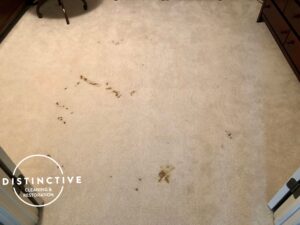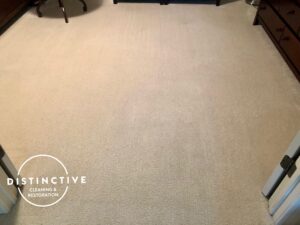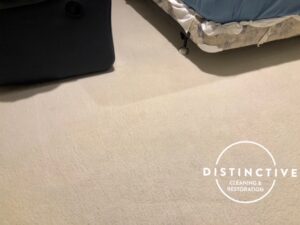Pet Stain & Urine Odor Removal Services in Fort Wayne

Benefits of Pet Stain & Urine Odor Removal
You love your pet… but you also love your home!
5 Questions For Pet Owners If Your Dog or Cat Leaves Their Mark with Fur, Dirt, Stains and Odors
- Should you get rid of your pet?
NO! They are part of your family. - Should you waste your time and money at unsuccessful stain and odor removal attempts?
NO! Few things are more frustrating. Maybe you tried to do it yourself or hired another cleaning company, but nothing changed, or the spots went away and then came back, or the carpet was discolored or bleached, or the odor was better for a while but then came back. - Should you replace the carpet?
In most cases, NO! - Should your home embarrass you when people visit because of pet stains and odors?
NO! NO! NO! - Should you call the professionals at Distinctive Cleaning & Restoration so your home can look and smell great again?
YES! Many products and companies claim to remove pet stains and odors, but not all of them work immediately and permanently like our system. Distinctive successfully removes pet urine odor and often the yellow, brown or red stains on carpet caused by pet vomit, urine or feces.
Pet Stain Removal Process
How Distinctive Removes Pet Urine, Vomit, Diarrhea or Feces Stains
- Pre-treat the spot to neutralize the pH.
- Rinse and extract the spot.
- Apply a specialized stain removal product to any remaining yellow or brown stain that would not clean out. Over the next 24 hours, the product will usually make the stain disappear as it dries. Learn what make some spots harder to remove than others below in our FAQ.
Pet Urine Odor Removal Process
Inspection
To successfully remove pet urine odor, the exact location of the odor source must be found using a combination of these four methods:
- Our Eyes – Where are the urine spots visible? Sometimes a previous cleaning removes the visible stains, but the odor remains.
- Our Nose – Urine stinks – follow the smell.
- UV/Black Light – Inspection with a black light can reveal much more damage than meets the naked eye. The ultra violet rays are on the same wavelength as pet urine, therefore urine glows under a UV/black light revealing the exact location of areas affected by urine.
- Moisture Detector – Urine salts develop which attract moisture from the environment. It may appear dry, but our sensitive moisture detector finds the moisture attracted to the urine to help us find the urine odor source.

Carpet in Daylight –
No Pet Stains Visible

Carpet Under Black Light – Pet Stains Visible

Carpet in Daylight –
No Pet Stains Visible

Carpet Under Black Light –
Pet Stains Visible

Our Moisture Probe Will Alert Us To Any Urine Salts (the source of the odor) in the Carpet and Pad Below
Does My Carpet Pad Matter?
After inspecting the location of the urine, it is important to consider what is below the carpet surface. We need to determine how severe the urine damage is and how many layers below have been affected.
Some carpet backing or carpet padding surfaces are “Water, Spill or Pet Proof” in the sense that there is a barrier that won’t allow anything to pass which keeps pet urine from soaking down into and affecting layers below the carpet.
However, pet urine can soak into and below normal carpet, affecting the carpet pad, tack strip and wood sub-floor or concrete foundation. A small spot on the surface may spread out into a large spot as it soaks in. Each affected layer must be treated to completely remove pet urine odor. This will affect what treatment method is chosen next.

Pet Urine Odor Removal Options

Option #1: Moderate Urine Damage To Carpet, 75-100% Success
- Affected spots identified during inspection.
- Specialized oxidizing deodorizer mixed and applied to saturate affected materials. (See our FAQ to learn what makes deodorizers different)
- Allow 30 minute dwell time.
- Extract using the Hydro-X or water claw. These are special weight assisted extraction tools that are connected to our powerful truck mounted machine to extract deodorizer that has soaked down into the pad and carpet backing.
- Normal cleaning process to rinse and extract the area.
- Drying after deodorizing will take longer than it does after just a normal cleaning. It could take a few days. Airflow from fans will help it dry faster along with our other drying tips here.
Watch a video demonstrating this process above or click here.
Option #2: Heavy Urine Damage To Carpet, 99-100% Successful
- Affected spots identified during inspection.
- Empty all furniture from the room.
- Disengage and pull carpet back.
- Remove old affected carpet pad.
- Clean sub-floor.
- Apply an odor barrier/sealer to the sub-floor, tack strip, baseboard and wall if needed. If these materials are affected, consider removal and replacement.
- Affected carpet is saturated with specialized oxidizing deodorizer.
- Allow 30 minute dwell time.
- Deodorizing solution is extracted from carpet with our powerful truck mounted equipment.
- Dry carpet.
- New carpet pad is installed.
- Clean and dry carpet is reinstalled.
- Replace furniture.
Option #3: Severe Urine Damage To Carpet, Guaranteed 100% Successful
In some situations, the best option is to replace the carpet and pad. Take into consideration the age and condition of the carpet, the severity of urine damage, what other areas match and the cost of deodorizing treatment.
Even if the urine odor can be removed, pet urine may have caused permanent discoloration or carpet delamination. In that case, replacement may be the best option. The sub-floor and any affected walls, baseboards or tack strip still must be properly cleaned and sealed before the new carpet is installed.
What About Oriental & Area Rugs with Pet Urine Stains & Odor?
Synthetic Fiber Rugs with Pet Stains:
These can be treated the same way wall to wall carpet is treated.
Synthetic Fiber Rugs with Pet Urine Odor:
These can be treated the same way wall to wall carpet is treated in Option #1 above.
Natural Fiber Rugs (Wool or Cotton) with Pet Stains:
The fiber type is the biggest factor in stain removal. Natural fibers may lose color if treated with our specialty pet stain removal solution. Instead, we have solutions that are safe to use on natural fibers to remove pet stains. Natural fibers are more delicate, so pet stains can be permanent. After drying, pet urine is a high alkaline pH, which can cause permanent staining, weakening of dyes that cause color to run/bleed and bleaching of color.
Natural Fiber (Wool or Cotton) Rugs with Pet Urine Odor:
Natural fibers can be damaged by our regular oxidizing deodorizer, so an enzyme or acid solution is used to remove the pet urine odor. Typically this requires the entire rug be fully submerged in the solution, rinsed, cleaned and dried.

Can Pet Urine Odor From Dogs & Cats be Removed From Upholstered Furniture?
Usually, yes. Similar to carpet, the severity and affected layers below the fabric surface must be considered. Typically, we can saturate the affected area with our deodorizer, allow dwell time, extract, clean, and dry. This is a successful process.
In severe cases, the stuffing of cushions and pillows may need replaced and then only the fabric upholstery would need treated.

Can Pet Urine Odor be Removed From Walls, Trim and/or Baseboards?
In most cases, yes! The walls, trim and/or baseboards can be wiped down with our deodorizing solution.
In severe cases, however, these materials may need re-painted, sealed or replaced.

Can Hard Surfaces Like Tile & Grout Be Affected By Pet Urine Odor?
Yes. Sanded grout between tiles or planks is porous and can absorb pet urine from dogs and cats. We use the same oxidizing deodorizer to remove the smell, then clean the tile & grout, leaving it looking great and smelling fresh.

Cleaning Photos

Pet Spots on Carpet – Before

Pet Spots on Carpet – After Removal

Pet Spots on Carpet – Before

Pet Spots on Carpet – After Removal

Pet Spots on Carpet – Before

Pet Spots on Carpet – After Removal

Pet Spots on Carpet – Before

Pet Spots on Carpet – After Removal

Pet Spots on Carpet – Before

Pet Spots on Carpet – After Removal

Pet Spots on Carpet – Before

Pet Spots on Carpet – After Removal
Pricing
Pet Stain Removal:
Visible pet stain removal pricing is based on how many spots need treated after cleaning and how much specialty removal solution is used during the removal process.
Pet Urine Odor Removal:
Urine odor removal is priced in addition to our regular carpet cleaning rate. It is based on how many gallons of the deodorizing solution we use.
It can be challenging to estimate a total price over the phone before inspecting all affected areas and determining the extent of the damage. One gallon of deodorizer covers roughly 6-8 square feet of carpet. The amount of solution will vary based on the severity, whether there is carpet pad or not, if the pad has a moisture barrier, the thickness of the carpet and the size of the area affected.
Tips to Prevent Pet Urine Stains and Odor
Access our Free Report to learn tips to prevent pet stains and odor.
Pet Urine Stain & Odor Removal FAQ
Usually. There are several factors that determine the success rate of removing yellow, brown or red pet stains from carpet and fabric from pet urine, vomit or feces.
- Fiber Type
- Olefin and polyester fibers are not absorbent, so most stains easily clean out.
- Nylon fibers can absorb stains. Sometimes they clean out and sometimes they do not. Specialized stain removal products are applied to any remaining stain with the hope of complete removal.
- Natural fibers like wool or cotton can be very absorbent, so stains are more likely to remain after cleaning. However, the specialized stain removal products have a risk of removing color from wool or cotton, therefore you must accept this risk before we proceed.
- Previous Attempts at Removal
- Some spotting techniques can distort the fibers from aggressive agitation. Some solutions can “set” the stain, making it more difficult to remove. Some solutions can permanently bleach out or remove color from the fiber.
- Severity
- Some stains may require multiple applications to reach 100% success. If the pet took medication this, can also affect the results. If the pet’s food has dyes, causing red stains, it may require a different stain removal solution.
No. Cleaning may remove stains, but removing pet urine odor is a totally separate process from cleaning and removing the visible stains. If the odor sources are not treated, the odor will remain and may even increase temporarily because of the additional moisture from cleaning.
Some companies will apply a deodorizer to the carpet surface, however this typically is a “Band-Aid” and is simply masking or covering up the bad smell. Our process actually removes the source of the bad odor. For example, after a hard workout at the gym, you may be sweaty and stinky. You could mist cologne or perfume to cover up the bad smell, or you could take a shower and remove the source of the odor so you are clean and fresh.
Urine leaves the body (man or animal) in an acid state, with a pH of about 5 to 6. It is generally contains no harmful bacteria, pathogens or microorganisms. However, it becomes the perfect breeding ground for those things as soon as it leaves the body. The main ingredient in urine is uric acid. It also contains yellow pigment, urea, cholesterol, enzymes, and small amounts of other chemicals. The uric acid begins to change immediately upon leaving the body. The warm acid state of the urine offers a friendly environment for bacteria, which begin to flourish almost immediately. In this original acid state, the urine begins to oxidize and react with the carpet to create a color change, which may become permanent if the urine is not removed from the carpet. As urine begins to dry, it changes its hydrogen content and forms crystalline salts, which take on an alkaline pH. Then the smell begins! When dried urine is re-moistened, it gives off an ammonia gas. Odors associated with urine come from two sources:
- Bacteria that grow abundantly in dark warm places with a never ending food source (the dog feeds the bacteria daily!). This bacteria growth and breakdown of the urine creates amino acids. These complex organic compounds work deep into carpet fivers until they are nearly part of the fiber. This can present a challenging situation. The waste materials and gases from the decomposing urine create an unpleasant odor.
- The second source of odor is chemical odor that remains even when the bacteria have been killed. This explains why more than disinfecting is necessary to neutralize odors from urine. Urine also presents additional odor problems when the relative humidity is high. The salts and crystals that are formed are hydrophilic and draw water to them. As the salts are reactivated by moisture, they give off a greater proportion of odorous gases.
Yes. A black light will cause urine contamination to glow in the dark. Most black lights operate at a wavelength between 380-415 nano-meters. Most bodily fluids including tears, saliva and semen will also fluoresce under a black light. The glowing part of these bodily fluids is called porphyrin.
Porphyrin is actually a group of organic compounds that has an attraction to metals. In the blood stream, these compounds attract iron and are one of the building blocks of hemoglobin, but they are also present in other body fluids. Other fluids such as the quinine in club soda, many vitamins, petroleum jelly, antifreeze, optical brighteners found in many consumer carpet spotters and laundry detergents also glow. These will usually fluoresce a bright white or even blueish hue, not the dull yellow of urine.
To understand why some substances glow under a black light and some do not we have to look at the atomic level. These compounds have an available electron orbiting it’s nucleus. When energy in the form of ultra violet light from your black light encounter these electrons, that energy is absorbed and excites the electrons to the point where they jump to a higher orbit around the nucleus. However, this energy is unstable and is quickly released by the electrons as visible light. This reaction happens super fast over and over again and this is the glow seen when using a black light. These photo reactive compounds penetrate carpet fibers and are nearly impossible to remove. Even after deodorizing and removing visible stains and odors, the previous stains will continue to glow under a black light. This does not mean the procedure failed or that there is still urine in the carpet.
No. There are eight different, primary odor control mechanisms. Most odor control formulations will utilize one as the primary component with other mechanisms blended in to broaden the scope of the product. Due to the complexity of the formulation and the costs of active ingredients you will find significant differences in the performance of products offered in the market place. Depending on the situation, Distinctive will choose the proper product to remove odors.
Below are brief descriptions of primary odor control chemistry in use today.
- Biological agents, often referred to as an enzyme, eliminate odors by metabolizing (eating) the odorous material. This is the chemistry used in many ‘do it yourself’ products. Enzyme’s performance varies based on their temperature and if they get to hot they are killed. Usually there is a surfactant mixed in with them which can leave a dirt attracting residue. Enzyme’s may require up to 72 hours to be effective. Distinctive would use this chemistry on an installed wall to wall natural fiber carpet that can’t be immersed like a loose rug.
- Pairing agents eliminate odors by bonding to the odor molecule. Thereby altering the shape of the odorous molecule so the olfactory senses no longer recognize the odor.
- Molecular encapsulation utilizes multiple bonding mechanisms to pull the odorous molecule into the active molecule and thereby absorb the odor much like a sponge absorbing moisture.
- Physical encapsulation occurs when a film-forming agent engulfs the odorous substance and physically prevents the release of odor.
- Molecular cleaving (oxidation): Reactions that chemically change (break apart) the odorous molecule and combine with it to form different substances. This is the chemistry used in the product Distinctive uses to remove odor from synthetic carpet and fabric fibers.
- Odor modification is based on the Zwaardemaker Conjugates theory where two different odors will cancel each other out. In odor control, fragrances are formulated that cancel out the most common odors encountered such as urine, feces, and mold.
- Emulsification: Acid based products designed to dissolve urine salts and neutralize ammonia and suspend the contamination so it can be rinsed away. This is the chemistry we use when immersing wool area rugs to remove pet urine odor.
- Masking agents simply provide a pleasant fragrance that mutes the malodor so as to make it more tolerable.
If your home has an “animal” smell, but there are no pet urine spots or urine odor, usually a thorough cleaning will rinse and extract pet hair, dander, oils etc. that cause the odor. We have a deodorizer that can be applied to the carpet that is made for this odor and is different than our normal pet urine odor oxidizing deodorizer.
There are many DIY deodorizers or ideas on the internet for removing pet urine. The main challenge of doing this yourself is applying enough deodorizing solution to saturate the affected areas and then extract the solution. Our weight assisted extraction tools and powerful truck mounted vacuum allow us to do this. Otherwise, issues can be caused by the carpet or pad being left wet and remaining that way for an extended period of time.
Changes in humidity/moisture levels. Have you cleaned a spot thinking it was gone, but then one day the odor mysteriously came back? Why? Urine is made up of three different parts. Many cleaning products remove the first component – the sticky liquid content. Some can even remove the second component – the stain-causing pigmentation. But nothing removes the third component – the uric acid crystals or “urine salts” that cause odor. You could clean this spot all day long and even our professional carpet cleaning solutions will not remove the odor. You must use a specialized deodorizer to remove the odor. When you clean or treat the spot, it may seem like the urine is gone because the stain and odor disappear. But the urine salts are still there. If 100% dry, urine salts have no odor. But when humidity levels change, or conditions are damp or humid, the urine salts attract moisture and reactivate, causing the terrible odor to return. This odor is unmistakable and sometimes smells similar to ammonia. Humidity levels can change for a number of reasons but here are two major reasons…
Change in Seasons. During the winter, the air is very dry. During spring and summer there is naturally more humidity. Even though nothing about the pet spot has changed, pet urine odor that goes unnoticed during the dry winter will suddenly have a terrible stench during the spring and summer.
Carpet Cleaning. Cleaning the carpet will change the humidity level in the house, especially if the areas affected by pet urine are only cleaned and not treated for odor. Odor from pet accidents may become more noticeable for a period of time after the cleaning because of the elevated moisture content. Generally, it will return to the same condition as before, after it has dried completely. We cannot be held responsible for such odors unless we can identify, treat and neutralize them.

